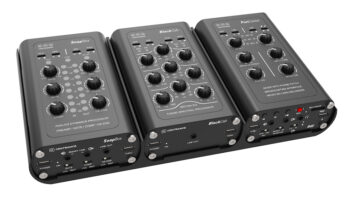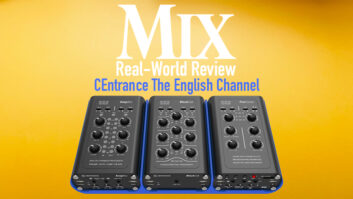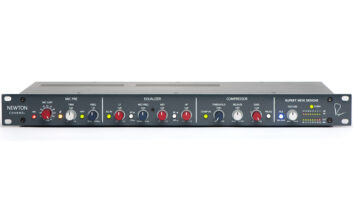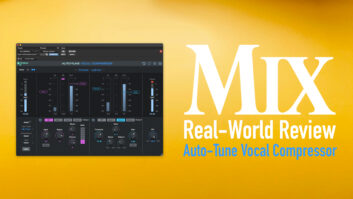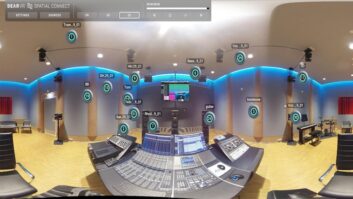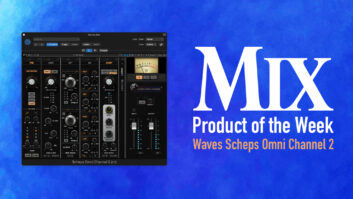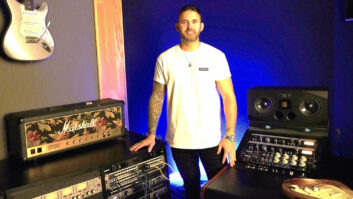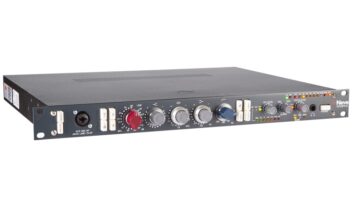In most live entertainment situations, and almost all of those that feature a singer, the FOH engineer’s highest priority is the lead vocal mic. For political speeches and other events that require sound reinforcement, including industrial and theatrical presentations, there is little competition for the listener’s attention. But in musical shows, the FOH mixer must often cope with a number of factors that can make it hard to position the lead voice clearly in the mix. Band members who are too loud on stage, complex studio-born arrangements, indifferent acoustics, noisy audiences and inconsistent mic techniques can all conspire to make the FOH engineer’s task difficult, if not impossible. To find out more about voice processing techniques and equipment choices in the live environment, Mix recently interviewed five leading FOH engineers. Our sincere thanks to Steve Guest, Tim LaMoy, Dave Lohr, Vance Powell and Laurie Quigley for their time and interest. See the sidebar for further details on our interviewees.
MIC CHOICESNot surprisingly, most of our interviewees felt that correct microphone choice is critical. Laurie Quigley, whose client list reads like a Who’s Who of metal and rock bands, is emphatic about his preference in wireless mics: “The Shure radio mics are the best ones out there,” he says. “Most of the vocalists I work for are using radio mics, and I’ll go with a Shure because I believe they have the best radio mics. They have the best dynamic range and don’t have dropouts. Does it compare to a copper wire out of the back of the microphone? No, it doesn’t. But it’s as close as I think you can get.” For general applications, Quigley favors Audio-Technica mics, which he uses for vocals when not using wireless systems.
Tim LaMoy, currently mixing FOH for Backstreet Boys, is using Sennheiser 5000 Series wireless mics for the five-man vocal group. “I like the condensers, but they don’t work well for the ear-monitor guys,” LaMoy explains. “So to make a happy medium, we use the Senn-heiser dynamic capsule. Also, the Boys use wireless Crown 311 headset mics, a nice snappy-sounding mic. It’s got great low end-I can tune the P.A. with that mic, and everything else sounds good.”
Steve Guest, a veteran of David Bowie and Janet Jackson world tours, is pragmatic. “If I have the luxury of working with an artist without a vocal mic preference, or one willing to experiment, I’ll absolutely try a few different models to find the one that suits them best,” he says. “But most artists I’ve worked with have been using a particular mic they like and prefer. For male vocals I’ll default to a Beta 58-at least they’re consistent and predictable. For female vocals, smooth midrange counts, and they seem better suited to condenser vocal mics.
“In general, the artist is really reluctant to give up something that’s comfortable, especially if he or she has been using it for a while. I have tried to get three different artists away from microphones I thought were less than ideal for them, and I had to give up every time. It’s just not worth it, because the comfort factor is too important-the discomfort that changing the mic causes is greater than any increase in fidelity that I get. I can usually adjust to the singer’s choice of microphone, if it’s any generally accepted good quality vocal mic.
“There’s not too many bizarre microphones you run into,” Guest adds. “But more and more people now are using wireless microphones, which are my least favorite. They still don’t sound as good as a hard-wired microphone-the clarity isn’t there.”
Dave Lohr commends the AKG C-535. “When it came out, the AKG C-535 was, and still is, a very good mic for a lot of vocalists,” says Lohr, who had been using it with Neil Young since 1989. “I know James Taylor does very well with it; it sounds incredibly good on his voice.” Nevertheless, Lohr recently switched Young to the Neumann KFS-150 hypercardioid after hearing him sing through it at the 1999 Bridge School benefit. “I was knocked out by the sound of [Young’s] voice through the mic alone and took the processing out of line,” recalls Lohr. “It sounded really good, and we ended up going with [the KFS-150] for his latest acoustic tour, using just some minor de-essing and minor compression.”
Of course, there are times when the FOH engineer’s first-choice mic may not be best for the artist. “A lot of mics that I’ve found work excellent for FOH don’t work particularly well for the monitors,” says Lohr. Pointing out that rehearsals are the best time to work out any necessary compromise, Lohr says that mic selection “has to be a collaboration between the artist, the monitor engineer and the house engineer. For example, with Carly Simon-she was on in-ear monitors-we were using a microphone that she wasn’t really happy with because of the raspiness of the sound in her ear monitor. We changed to the AKG Tri-Power 5900, which has a rich, almost ribbon-like low end and mid-range, and she was much happier with it. It also seemed to balance really nice with her voice in the P.A., so we solved two problems there.”
ENTER MR. DYNAMICA major factor in microphone choice is the artist’s technique. “With most vocal mics, as long as the guy keeps it close to his mouth, you’re fine,” says Quigley. “If you get a guy who wants to be Mr. Dynamic and is pulling the mic away and trying to make these high notes, then all you’re picking up is snare drum and guitar amps. If the vocalist has reasonable technique and keeps the mic close to his mouth, you’re fine.”
Guest agrees. “The only time I run into a problem is just with the mic techniques, if they’re too far off-mic,” he says. “Generally, a good monitor engineer can take care of that. The biggest danger when you get ear monitors in the mix-which are good, because they clean up the stage so much-is if the ear-monitor engineer is using a lot of compression and lower thresholds, and the artist can crank up his own ear- monitor system to the point where they can hold the mic about two feet away and still hear themselves really well-that’s a problem. The monitor engineer has to be aware that this can be a problem for front of house. It’s great for the artist and the monitor engineer, because the artist thinks the guy is doing such a great job that he can hold the microphone so far back like that and still hear, but it’s actually destructive for the rest of the show.”
“The main thing is you work with the vocalist to get his technique correct,” adds Quigley. “If it’s correct, then you’re getting good signal to the microphone, and you can do what you need to do. If you’re not getting signal, you can’t make it up. You need the initial signal.”
Vance Powell, who has spent the last year and a half mixing FOH for Jars of Clay, is familiar with the problem. “The lead singer for the Jars is one of the hardest to deal with vocally of anybody I know,” he says of singer Dan Haseltine. “He just doesn’t sing loud. He’s a very low-level, breathy, emotional singer and goes from whispers to screams at any given moment, but mostly his vocal level is quite low. I’ve experimented with a few things, and the only thing I’ve found that really works for his vocal is an Audix OM7 capsule on a Samson wireless.”
Quigley underlines the importance of reliability. “When you’re doing rock bands, you can’t have a microphone that sounds high-fidelity and beautiful but won’t get through the first song,” he notes. “When it comes to vocal mics on cables, your old standards are Shure SM57s and SM58s. They are mics that always work. You can beat the living hell out of them, put them in and out of trucks every night, they can go through different humidity levels and still deliver all the time.”
TWEAKING THE MONEY CHANNELAsked about his usual vocal processing signal chain, Lohr notes that, with the right artist, it is often hard to improve on the correct microphone choice and an experienced hand on the fader. “The right mic and a little compression, that’ll usually take care of it,” says Lohr. However, he names the Crane Song STC-8 compressor and the discontinued UREI LA-22, a dynamic equalizer often used for de-essing, as his favorite pieces of outboard gear. He also mentions the BSS DPR-901 dynamic equalizer. “I use it occasionally-other people use it with great success-but I tend to shoot more for a mic change and a mic preamp change,” he says.
Quigley’s favorite compressor is the Summit TLA-100 leveling amplifier, followed by the Empirical Labs Distressor. “I also use a BSS 901 as a frequency-dependent limiter,” says Quigley. “I try to keep my vocal channels as flat as possible, maybe adding a hair of high end, taking away a hair of bottom. I think if you set your sound system up correctly, you should be able to run the vocal channel reasonably flat-I don’t really agree with adding or subtracting huge amounts of EQ. Now and then you have to work with a vocal that needs radical things done to it, but in general I don’t like doing that.”
Guest often carries a small rack of outboard gear specifically designed for the lead vocal channel. “I work with a few people who move around the planet quite a bit, and I don’t have the same console every day,” he explains. Guest’s setup includes a high-quality preamp, a parametric equalizer and a tube compressor with a sidechain; the line level vocal channel output is then inserted into the board on a fader. “This gives me a sonic consistency,” Guest says. “It’s amazing how much character the board will impart to a signal every day. This setup really minimizes that to the point that it becomes very predictable.” Once Guest has his vocal processing channel set up correctly for the artist, he can use that as a reference for tuning the P.A. “It gives me a level of consistency, and I spend less time monkeying around with that very important part of the show and more time on other things. I can spend more time on the P.A. itself and the rest of the band,” he notes.
Guest’s setup is designed to cope with a “nonlinear” singing voice. “If you’re trying to run a vocal really up in the mix and the singer has a really narrow power band, you need to get control of that,” explains Guest. “If you try to take it out too much with EQ, you ruin the tonal quality of the vocal. So I’ll go for the sidechain EQ to try to get control over an area instead of trying to use too much EQ. I try not to use any more EQ than I need to make the vocal mic itself sound good.”
Though the components in Guest’s vocal processing signal chain often change, he has recently been using the ATI Pro6 and Focusrite Red preamps and names Drawmer and Summit models as his favorite tube levelers. “The compression ratio depends on the artist,” adds Guest. “If they’re really dynamic, I have to compress it a bit, because I like to keep the vocal right up in the mix, and the more you want it in your face the more compression you have to put on it-to a point; then you start robbing too much dynamics. So it really depends on the artists; if they give you a consistent level, then you don’t have to use that much.”
PRESERVING TONAL QUALITYGuest prefers “frequency sensitive” compression, triggered via the compressor’s sidechain, to “frequency selective” compression or dynamic equalization. “I’d rather preserve the tonal quality of the vocal and just let the compressor do the overall gain reduction adjustments based on the contour of the sidechain and the threshold setting of the compressor,” he explains. “You can monitor the sidechain EQ to zero in on problem areas, and it seems smoother and easier to control that way. If you find yourself going after specific frequencies with a dynamic EQ, it might be a tuning problem with the P.A. system rather than the vocalist.” As for the compressor sidechain equalizer, “any third-octave will work,” says Guest. “It doesn’t really matter because it’s not in the signal path.
“The one parametric EQ that seems to keep popping back in the rack consistently is the Meyer Sound CP-10,” Guest continues. “I am insistent about having that, though I’m very flexible in a lot of other areas.” Guest points out that the stereo CP-10 allows him to set up identical signal chains for the main and spare vocal channels.
Lohr recalls that he arrived at a similar solution for a singer whose vocal character and delivery would change radically, even within the same song. “It could dramatically change over from a deep, thick, low-end whisper-type voice to a real raspy, upper-midrange, nasal sound,” says Lohr. “I had to carry a mic preamp, an EQ, a de-esser and a compressor in a two-space rack so that I could control the voice. However, once it was dialed in, it turned out so well that we went in the studio and did a record with the same setup. It translated well from live performance to the studio.” Lohr’s voice processing setup at first included API mic preamps and EQs (312 and 550A studio modules), but after changing the vocal mic to the large-diaphragm AKG D-5900, he switched to an Amek 9098 mic pre/EQ and a UREI LA-22 de-esser.
Powell has also arrived at a voice processing solution for Jars of Clay, but in a single unit. He feeds the vocal mic line into an ATI Pro6 preamplifier/vocal processor. “It’s basically a single channel out of a Paragon console,” explains Powell. “With the Pro6 I get plenty of vocal gain, and even under large amounts of compression it doesn’t cloud it up, it doesn’t roll the high end off.” The Pro6 includes a mic preamplifier, a highpass and lowpass filter section, 4-band fully parametric EQ, a compressor and a gate. “It’s a genius piece,” says Powell. “It usually fits in my FOH rack, and I always bring it back in the insert return and bypass the board preamp, even on the Midas XL4. Once it’s set, I can forget it, and, since I’m always coming back into the desk on the insert, even if we use another desk my gain staging is the same.”
To help manage his three background vocal inputs for Jars of Clay, Powell uses the D3 Puresound Mic-Mute0[superscript]TM, a phantom-powered infrared gate that switches the mic channel on when a singer approaches. “They’re adjustable for distance and have really helped with the stage ambience,” says Powell. The keyboard player has two Beyer M700 microphones, one over his Wurlitzer and one over his B-3, which are both run through Mic-Mutes and into a Y cable. “I combine them to one channel,” explains Powell. “Because of the gates, I never hear the other mic, so it’s a simple fix-I only have one channel, and one set of processing, reverbwise.”
PREFERRED REVERBS AND DELAYS”I have a tendency not to use that much reverb,” says Guest, noting that for live work he prefers to use delay effects. “If it’s a ballad, then I’ll put some reverb on, but I’m not a huge fan of reverb-I get tons of it naturally from the hall or arena, and slathering the vocal with even more of it doesn’t help, except outdoors and in really [acoustically] dead venues. I like an [Eventide] H3000 and a good stereo delay, working together.”
Powell, on the other hand, is a reverb enthusiast. “I think the [Lexicon] PCM80 is the greatest thing since sliced bread,” he says. “My rack on the upcoming tour is going to be three PCM80s and one H3000. With the PCM80s, 90s, 81s, 91s, I think that Lexicon has the market on natural, real-sounding reverbs. The 80 and the 81 are my particular favorites for vocals. With the Jars, I carry my own little rack for ‘fly’ dates-my ATI and a PCM80. The PCM80 has all the wonderful reverbs and has a lot of echo patches under the reverbs, so I can get by without a delay unit by using the tap tempo function on the PCM80. That helps from time to time when we’re doing a fair or festival and not carrying an FOH rig. I don’t have to go dial up a bunch of other reverbs; I’ve got it all in one box.”
Lohr generally uses “two nice-sounding reverbs, one a chamber and one a plate, and I mix and match the two sets of algorithms together-that seems to give me the most consistency in day-to-day use.” He also uses Lexicon 480Ls or 300s. “They have a warm plate that sounds very, very good,” he notes.
LaMoy has been using TC Electronic M5000s for Backstreet Boys’ vocals and also uses a Lexicon 480, together with a TC Electronic 2000 for delay. “I also love the TC 5000’s GM Hall preset,” says LaMoy. “I go in and doctor the parameters a little bit, and I’ve got a great, really brilliant hall sound. It’s one of my favorites.”
Quigley’s preferred reverbs are all Lexicon models. “I use two 480s and a 224XL,” he explains. “The reason I use the 224 is the plate and a reverb patch called Inverse Room, which is something I really, really like-a very, very tight reverb that gives you an apparent feeling of more volume. That’s the only Lexicon machine that program came on.” He also uses a TC Electronic 2290 unit for doubling effects on the main vocals and the Eventide H3000 or H3500 for pitch change and doubling effects on harmony and background vocals.
But, as Quigley points out, getting the reverb just right is often the least of the FOH mixer’s concerns. “I’ve worked with acts that are incredibly loud, such as Motley Crue, where you’ve just got to work to get over the stage volume,” recalls Quigley. “There’s no point trying to tell a musician to turn down, it ain’t going to work. It never has; it never will. What you try to do is get the stage sound as good as possible so that the P.A. is working with the stage sound. Then you put the vocals over the top of it.
“It has got easier in the past few years because of in-ear monitoring,” notes Quigley. “The majority of hard- rock band vocalists these days are going to in-ears, which makes it a lot easier for the vocalist to pitch and to hear himself. He’s not having to fight against three or four hundred thousand watts of Marshalls, excuse the exaggeration.”
Mix would like to thank the following FOH engineers for sharing their expertise:
Steve Guest started out in a recording studio in Baltimore, joined Maryland Sound Industries in 1983, and has been an independent since ’95. Guest has toured as FOH engineer with Ricky Martin, David Bowie, David Sanborn, Janet Jackson, Bette Midler, Cyndi Lauper and Paula Abdul. Most recently he has been in Japan working with artists Tomoyasu Hotei and Miki Imai.
Tim LaMoy has been a staff engineer with MD Systems (Nashville) since 1993. Currently mixing FOH for Backstreet Boys, he was with Charlie Daniels for six years.
Dave Lohr started his career with Northwest Sound and Quarterflash, then joined Maryland Sound Industries (which absorbed Northwest in 1982). A veteran of Super Bowl and Pink Floyd shows, Lohr has mixed for Carly Simon, Crosby, Stills & Nash, Hall & Oates, Dan Fogelberg, John Hiatt and George Benson. Lohr is now working with David Sanborn and Neil Young.
Vance Powell is a staff engineer with MD Systems (Nashville), where he handles industrial shows when not mixing FOH for the Grammy Award-winning alternative/contemporary Christian band Jars of Clay. He has also mixed for Tammy Wynette (five years), Nanci Griffith and Martina McBride.
Laurie Quigley started his career with TASCO in England in 1981 and moved to the U.S. in 1984 with Whitesnake. Originally from Australia, Quigley has since worked with numerous big-name rock bands, including Motley Crue (ten years), Ozzy Osbourne, Dio, Cinderella and Tesla. He has been mixing FOH for Aerosmith for the past two-and-a-half years.
